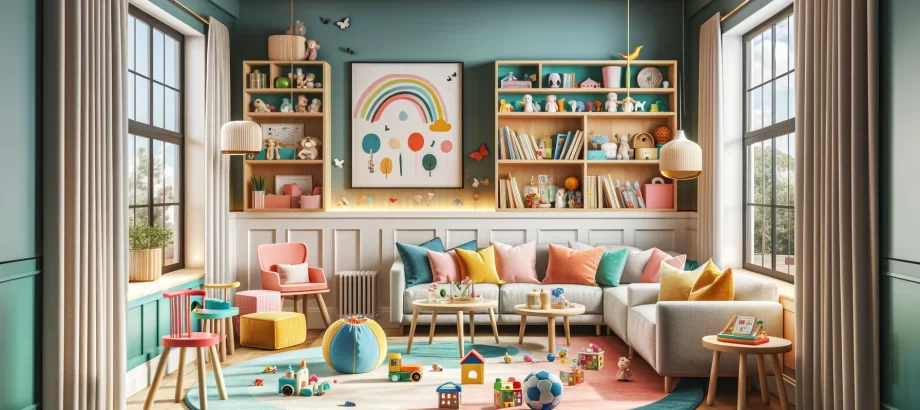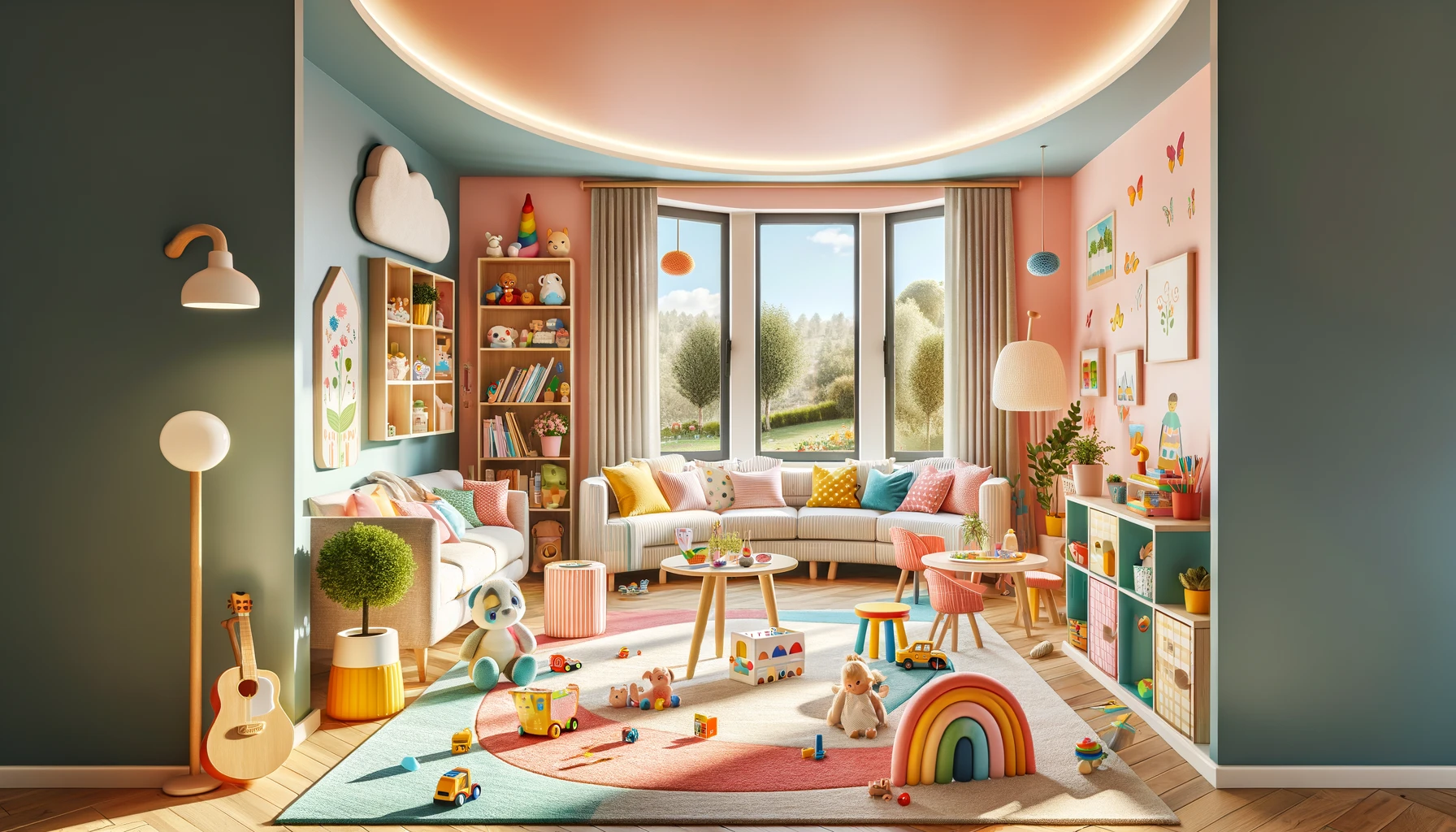How to Design a Child-Friendly Living Space

Hey there, are you looking to create a killer living space that’s totally kid-friendly? Well, you’ve come to the right place. In this article, we’re gonna dive deep into the strategies and key elements that’ll help you design a living space that’s not only safe but also super inviting for your little ones.
From hand-picking the perfect furniture to choosing flooring options that’ll keep them safe, and jazzing things up with some playful decor, we’ve got you covered.
So, buckle up and get ready for a journey that’ll result in a living space where your kids can unleash their creativity, explore, and most importantly, stay safe.
Interior Painters in Houston →
Key Takeaways
- Ergonomic seating and adjustable furniture are essential for promoting comfort and proper posture.
- Incorporating storage solutions and multifunctional furniture helps keep the space organized and maximizes functionality.
- Safety measures such as soft and cushioned flooring, non-slip surfaces, and securing heavy furniture are crucial to prevent accidents and ensure child safety.
- Playful and educational decor, including interactive wall decals and learning-inspired furniture, create a fun and engaging environment for children to learn and explore.
Choosing the Right Furniture
When designing a child-friendly living space, it is essential to carefully select the appropriate furniture that meets the specific needs and safety requirements of children. One important consideration is ergonomic seating, which ensures that children maintain proper posture and comfort while sitting. Ergonomic chairs with adjustable height and backrests can provide the necessary support for growing bodies.
Additionally, incorporating multifunctional pieces into the space can maximize functionality and versatility. For example, a convertible sofa bed can serve as both seating and sleeping space, saving room and accommodating various activities. Similarly, storage ottomans or benches with built-in compartments provide an opportunity to organize toys and belongings while also serving as additional seating.
Incorporating Safe Flooring Options
When designing a child-friendly living space, it is essential to incorporate safe flooring options.
One important consideration is to choose soft and cushioned surfaces to minimize the risk of injury from falls.
Non-slip surfaces are also crucial to prevent accidents, especially in areas prone to spills or water.
Additionally, opting for flooring that is easy to clean helps maintain a hygienic environment for children.
Soft and Cushioned
Incorporate safe flooring options that are soft and cushioned to create a child-friendly living space. When designing a living space that caters to children, it is essential to prioritize their safety and comfort. One way to achieve this is by selecting flooring options that are soft and cushioned. These types of flooring provide a gentle surface for children to play, crawl, and explore without the risk of injury.
Additionally, incorporating cushioned seating in the form of sofas, chairs, or floor cushions can further enhance the child-friendly atmosphere. To add a touch of vibrancy and joy, opt for child-friendly colors in your flooring and seating choices.
Non-Slip Surfaces
To ensure the safety of children in a child-friendly living space, it is important to incorporate non-slip surfaces and choose safe flooring options. Slip prevention is crucial to avoid accidents and injuries, especially in areas where children are likely to play or run around. When selecting flooring materials, it is essential to prioritize those that offer good traction and grip. Here are some childproofing surfaces options that can be considered:
| Flooring Options | Features |
|---|---|
| Rubber | Durable, shock-absorbent, and slip-resistant. |
| Cork | Soft, cushioned, and provides good traction. |
| Carpet | Provides a soft and padded surface, reducing the risk of injury from falls. |
| Vinyl | Easy to clean, water-resistant, and offers good traction. |
Easy to Clean
Incorporating safe flooring options in a child-friendly living space includes prioritizing materials that are easy to clean. When designing a space for children, it is important to choose flooring that can withstand the wear and tear of everyday life. Opting for materials that are stain resistant and require easy maintenance will make cleaning up spills and messes a breeze.
Consider options such as vinyl, laminate, or ceramic tiles, as these are known for their durability and resilience. These types of flooring are not only practical but also provide a safe and hygienic environment for children to play and explore.
By choosing easy-to-clean flooring, parents can create a worry-free living space where their children can freely express themselves.
Now, let’s move on to the next section where we will discuss creating ample storage solutions.

Creating Ample Storage Solutions
One effective solution for creating ample storage in a child-friendly living space is to utilize the child’s own belongings by incorporating a designated storage area for them. This not only encourages the child to take responsibility for their belongings but also ensures that everything has its own place, promoting a sense of order and organization.
Here are some creative organization ideas to maximize storage in a child-friendly living space:
- Install wall-mounted shelves or cubbies to display and store toys, books, and art supplies.
- Utilize under-bed storage bins or drawers to store out-of-season clothing or bulky items.
- Opt for multi-functional furniture, such as ottomans or benches with hidden storage compartments, to maximize space.
Selecting Child-Friendly Fabrics and Materials
When designing a child-friendly living space, it is important to carefully select fabrics and materials that are both durable and safe for children to use and interact with.
Eco-friendly materials are a great choice for creating a sustainable and non-toxic environment for children. Look for fabrics made from organic cotton or bamboo, which are free from harmful chemicals and pesticides. These materials are not only better for the environment but also for your child’s health.
Additionally, consider budget-friendly options such as microfiber or polyester blends, which are known for their durability and easy maintenance. These fabrics are stain-resistant and can withstand frequent washing, making them ideal for households with children.
Adding Playful and Educational Decor
When designing a child-friendly living space, it is important to consider adding playful and educational decor.
Interactive wall decals can engage children’s imagination and creativity, while learning-inspired furniture can provide opportunities for both play and education.
Additionally, fun educational artwork can serve as a visual aid for learning and create a stimulating environment for children.
Interactive Wall Decals
To enhance the playful and educational atmosphere in a child-friendly living space, consider incorporating interactive wall decals. These fun and interactive decorations not only add visual appeal to the room but also provide opportunities for interactive learning and creative play.
Here are three reasons why interactive wall decals are a great addition to any child-friendly space:
- Engaging learning: Interactive wall decals can feature educational content such as alphabets, numbers, and shapes. Children can actively engage with these decals, helping them to learn and reinforce their knowledge in a fun and interactive way.
- Imaginative play: Interactive wall decals that depict scenes like a cityscape or a forest can encourage children to engage in imaginative play. They can create stories, pretend play, and develop their creativity while interacting with these decals.
- Customizable and removable: Interactive wall decals can be easily customized to suit the child’s interests or changed as they grow. They are also removable without damaging the walls, allowing for flexibility in design and layout.
Learning-Inspired Furniture
To further enhance the interactive and educational atmosphere in a child-friendly living space, it is beneficial to incorporate learning-inspired furniture that adds playful and educational decor. By strategically placing furniture that engages children’s curiosity and encourages creative play, you can create a space that fosters learning and exploration.
One way to achieve this is by incorporating learning-inspired toys into the furniture design. For example, a table with a built-in puzzle or a chair with an interactive bookshelf can provide opportunities for children to engage in hands-on learning activities. These furniture pieces not only serve a functional purpose but also stimulate their imagination and cognitive development.
Another idea is to create creative play spaces within the furniture. This can be done by incorporating hidden compartments, secret doors, or modular pieces that can be rearranged into different configurations. By allowing children to take control of their environment and make choices, you empower them to explore their creativity and problem-solving skills.
Here is an example of how learning-inspired furniture can be incorporated into a child-friendly living space:
| Furniture Piece | Features |
|---|---|
| Table | – Built-in puzzle <br> – Storage compartments |
| Chair | – Interactive bookshelf <br> – Comfortable seating |
| Bookshelf | – Adjustable shelves <br> – Colorful design |
| Play area | – Modular pieces <br> – Soft and safe materials |
Fun Educational Artwork
The inclusion of fun educational artwork in a child-friendly living space enhances the playful and educational atmosphere. By incorporating artwork that is both visually appealing and educational, children are encouraged to engage in fun learning activities and explore their creativity.
Here are three ways in which fun educational artwork can contribute to creating engaging play spaces:
- Interactive Wall Art: Install interactive wall art that allows children to actively participate and learn. This can include magnetic boards, chalkboards, or interactive murals that spark their curiosity and imagination.
- Alphabet and Number Prints: Display colorful prints featuring the alphabet or numbers to promote early literacy and numeracy skills. These prints not only decorate the space but also serve as visual aids for children to learn and practice their letters and numbers.
- Science and Nature Artwork: Hang artwork that showcases different scientific concepts and nature scenes to foster a sense of wonder and curiosity about the world. This can include prints of animals, planets, or the human body, providing children with opportunities to explore and learn about the natural world.
Designing a Layout for Easy Supervision
Creating a layout that allows for easy supervision is essential when designing a child-friendly living space. To ensure your child’s safety while giving them the freedom to explore, consider implementing specific supervision techniques and using a child-friendly color palette.
When designing the layout, arrange furniture and play areas in a way that allows you to have a clear line of sight to all areas of the room. This will make it easier to supervise your child’s activities and intervene if necessary.
Additionally, choose furniture and decor in bright, cheerful colors that appeal to children and create a welcoming atmosphere. A child-friendly color palette can include vibrant shades of blue, green, yellow, and pink, which can stimulate their imagination and promote a sense of joy and playfulness.
Enhancing Safety Measures and Childproofing
Enhancing safety measures and childproofing is crucial in designing a child-friendly living space. Creating an environment that promotes freedom and exploration while ensuring the safety of children is of utmost importance. Here are some key points to consider when enhancing safety measures and childproofing:
- Install safety gates at the top and bottom of staircases to prevent accidents and falls.
- Use childproofing locks on cabinets and drawers to keep hazardous items out of reach.
- Secure heavy furniture and appliances to prevent tipping accidents.
Frequently Asked Questions
How Can I Incorporate Sensory Play Elements Into the Design of a Child-Friendly Living Space?
Inclusive play can be enhanced in a child-friendly living space through the incorporation of sensory play elements. Creating a sensory garden or using tactile materials and interactive toys can stimulate a child’s senses and promote their overall development.
What Are Some Tips for Creating a Designated Homework or Study Area Within the Living Space?
When creating a designated homework or study area within a living space, it is important to consider factors such as creating a quiet reading corner and utilizing wall space for organization. These elements can contribute to an effective and productive study environment.
Are There Any Recommended Color Schemes or Themes That Work Well for a Child-Friendly Living Space?
When designing a child-friendly living space, it is important to consider color schemes and themes that create a stimulating and engaging environment. Additionally, incorporating natural light and storage solutions for toys and books can enhance the space.
How Can I Create a Designated Space for Arts and Crafts Activities in the Living Area?
When creating a designated space for arts and crafts activities in the living area, it is important to consider factors such as accessibility, organization of supplies, and the need for adequate workspace for the child’s creativity to flourish.
Are There Any Specific Safety Precautions I Should Take When Incorporating Indoor Plants Into a Child-Friendly Living Space?
When incorporating indoor plants into a child-friendly living space, it is important to take specific safety precautions. Childproofing indoor plants and preventing accidental ingestion are crucial to ensure the well-being of children in the space.
